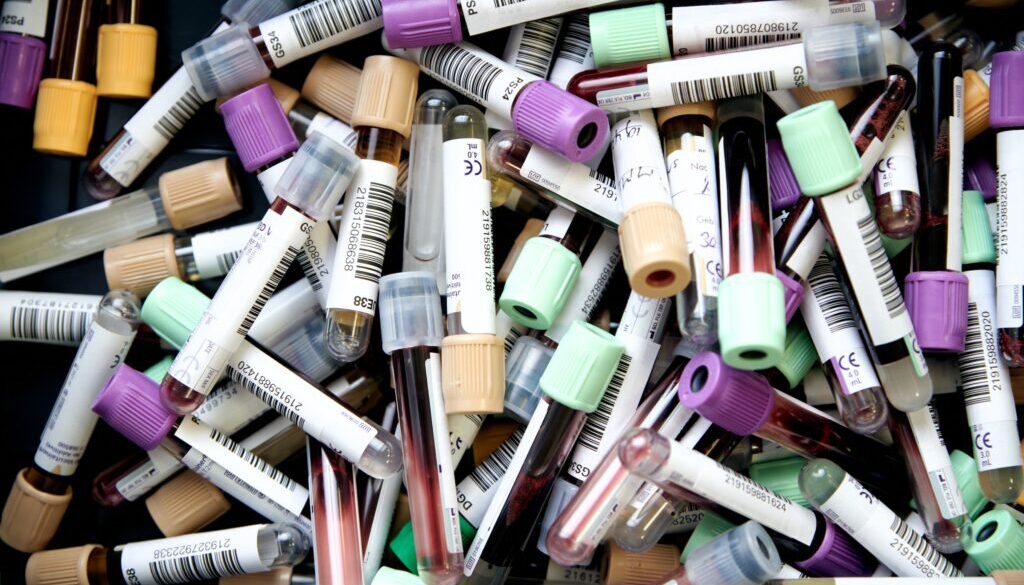PFAS chemicals linked to thyroid cancer, human data suggests
Exposure to some per- and polyfluoroalkyl substances (PFAS) may increase thyroid cancer risk, according to a study published Tuesday.
The analysis, which compared blood samples from 88 people who developed thyroid cancer with samples from people who did not, is the first to document an association between PFAS and thyroid cancer, which had been previously hypothesized. Past research has linked these endocrine-disrupting chemicals to thyroid disease, a condition in which the gland produces too many or too few hormones. The new research adds to a growing list of health problems linked to PFAS, including kidney cancer, testicular cancer, ulcerative colitis, high cholesterol, and hypertension during pregnancy.
The study, which looked at eight different types of so-called “forever chemicals,” found that doubly high levels of perfluorooctanesulfonic acid (PFOS) in the blood corresponded with a 56% higher risk for thyroid cancer diagnosis. The PFAS chemicals perfluorononanoic acid (PFNA), perfluorooctylphosphonic acid (PFOPA), and perfluorohexanesulfonic acid (PFHxS) were also found to be associated with thyroid cancer.
“Although preliminary, this is an important study highlighting the risk of thyroid cancer derived from PFAS contamination of water and soil,” said Luca Chiavato, a professor of endocrinology at the University of Pavia in Italy who was not involved with the study.
There are over 12,000 types of PFAS chemicals, which have been used in the manufacturing of many popular consumer goods as well as in industrial processes. The chemicals do not naturally break down and can leach into drinking water from industrial sites, sewage treatment plants, landfills, or certain firefighting foams. A 2022 analysis found detectable PFAS levels in about 83% of US waterways, with concerns about the widespread contamination leading the Environmental Protection Agency (EPA) to propose national drinking water standards for six types of PFAS last spring.
The chemical giants 3M, DuPont, and others agreed to settlements over the summer to provide affected communities with billions of dollars to test for the toxic chemicals and remove them from their drinking water. Water utilities across the country will decide in the next three months whether to join the settlements. Meanwhile, Connecticut residents recently filed a class action lawsuit against two of the state’s water suppliers over PFAS in their drinking water, while PFAS producers are challenging a class action suit in Ohio that could include as many as 11.8 million residents.
The EPA announced on October 20 that it has closed a loophole that allowed industry to get out of reporting small amounts of PFAS released during manufacturing, mining and other activities.
Driving thyroid cancer?
Thyroid cancer diagnoses worldwide have risen sharply in recent years, with a 20% increase from 1990 to 2013. But while scientists have previously suspected that PFAS exposure is contributing to the trend, there has been a lack of studies in human populations.
“The uniqueness of the study we did is that we were able to use these blood samples that were taken before the participants of this biorepository we have at Mount Sinai Hospital were diagnosed with cancer,” said Maaike van Gerwen, a director of research in the New York-based hospital’s department of otolaryngology.
Van Gerwen and colleagues matched blood samples from 88 people who were later diagnosed with thyroid cancer to samples from healthy people, which were matched for age, sex, body mass index, race, and, when possible, whether or not they smoked. The researchers also performed a separate analysis with samples from 31 people who had their blood samples taken at least a year before they were diagnosed with cancer, allowing them to better account for the time between when the participants were exposed to PFAS and when they developed cancer, said van Gerwen.
“We were limited to the number of thyroid cancer patients in [the biobank],” she said. “It’s a relatively small study. In the paper, we definitely recommend redoing this work with a larger population.”
While perfluorooctanoic acid (PFOA) is the only PFAS chemical classified as “possibly carcinogenic to humans” by the International Agency for Research on Cancer, it was not found to be significantly associated with thyroid cancer within the new study, said van Gerwen.
“That’s definitely something to reevaluate,” she said. Van Gerwen added that she would also be interested in learning if some of the more recently introduced PFAS chemicals are associated with thyroid cancer, which she said would require a larger sample size.
Next, van Gerwen and colleagues plan to replicate their study using a bigger, Europe-wide collection of blood samples from thyroid cancer patients. The researchers also hope to collaborate with veterans affairs hospitals to study links between PFAS exposure and thyroid cancer in military personnel. More than 700 military sites around the US may be contaminated with the toxic chemicals, putting service members and their families at elevated risk.
(Photo by Testalize.me on Unsplash.)
 EWG
EWG


